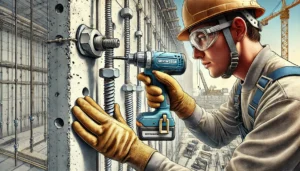It is necessary to implement and maintain strict fire safety policies in all industries in order to protect lives, buildings, and ensure business continuity. The entire fire safety plan incorporates a range of devices that can identify, notify, extinguish, and assist with safe exit during fire incidents. Outlined below is a list of the fire safety measures that are recommended to be adopted by all industries:
1. Fire Alarms and Smoke Detectors
Determining the placement of the fire alarm box alongside the smoke detector for early identification of fire or smoke is an important step. Fire alarm systems are recognized as the most critical safety equipment that comprises a control panel alongside smoke detectors that promptly order the alarm in case of a fire outbreak. Such systems may be set off either automatically upon detection of high heat, smoke, or flame, or through manual control. They also require consistent upkeep and testing in order to ensure maximum performance.
2. Fire Extinguishers
Firefighters that can prevent and manage small scale fires are critical to the protection of people and property. Investing in a portable fire extinguisher is one step towards preventative measures from a larger, more costly fire. They should also be chosen appropriately to match the fire hazards that are found in the area. Below are the most common uses for different types of electrical equipment:
- Class A: For ordinary combustibles like wood and paper.
- Class B: For flammable liquids such as oil and gasoline.
- Class C: For electrical fires.
- Class D: For combustible metals.
- Class K: For kitchen fires involving cooking oils and fats.
To guarantee their efficiency, continuous surveillance and instructor assistance on the right application are extremely important.
3. Fire Suppression Systems
In cases of high risk or zones where fighting a fire is not feasible, these systems are a must. These are known to fight fires without waiting for anyone to press the panic button. A few examples are:
- Sprinkler Systems: These systems are very common in most industries. They are designed to let water automatically flow once a fire is detected.
- Gas-Based Systems: These are useful in spaces where electronics are sensitive, as they make use of inert or chemical gases to quench fires.
- Foam Systems: These systems work well for chemical plants and fuel holding sites as they apply foam on flammable chemical liquid fires to put them off.
4. Emergency Exit Signs and Lighting
The escape signs have to be illuminated and placed correctly if they are to direct people in case of a fire. Emergency lighting guarantees that even if there is a power loss, everyone knows where to locate the exits. This allows for a more organized evacuation. Escaping routes should be clearly visible. Regular checks should be carried out to see if all the signs and lighting are okay.
5. Fire Resistant Doors
Fire Resistant doors are used to restrain the flames and steam from propagating throughout the building. These doors are able to endure a certain magnitude of fire for a given period of time, this helps in protecting other sections of the structure and offers its occupants time to evacuate the building. It is very important that fire doors are kept closed, as well as not blocked open with any objects.
6. Fire Blankets
For small fires, a fire blanket is a very useful tool. They are also effective for smothering a person whose clothing is on fire. Fire blankets are particularly handy in the kitchen and laboratories where small fire bursts can be very common. Keeping fire blankets close and training people on how to use these effectively increases their usefulness.
7. Spark Extinguishing Systems
These systems are very important to stop fires in industrial dust collection and pneumatic conveying systems. Spark quenching systems are essential in places that perform woodworking or metalworking, as these processes emit sparks. The systems are crafted in a way to detect the sparks and quench them before any fires or explosions can be initiated.
8. Carbon Monoxide Sensors
Though they aren’t advanced fire sensors, Carbon Monoxide detectors are necessary to track down the presence of this invisible and scentless gas emitted in the aftermath of improper burning. These sensors should be used where combustion devices are present. These alarming devices could avert individuals from being poisoned to death.
9. Personal Protective Equipment (PPE)
In some industries, employees need to be equipped with fire-protective PPE like shields, gloves, and clothing needed to carry out work related to fire and for emergencies. PPE such as helmets should meet safety standards and proper training should be given on its usage as part of the fire regulations program.
10. Fire Safety Training and Evacuation Plans
The physical protective equipment aside, every employee should undergo comprehensive informative fire safety reasoned courses. Employees should be taught how fire protection tools should be used, how to handle emergencies, as well as regular participation in fire drills. With evacuation plans properly developed and periodically changed, everyone would know what to do when there is a fire and try to lessen chaos and speed the evacuation.
To apply these measures, fire risks in your industry and facility have to be evaluated comprehensively. All this planning, as well as procedures and equipment, will require frequent maintenance and checks to ensure that everything is in good working condition. Making fire safety a priority means that every information industry can safeguard the most important assets they have – people and properties – while meeting regulations and standards safety norms.










